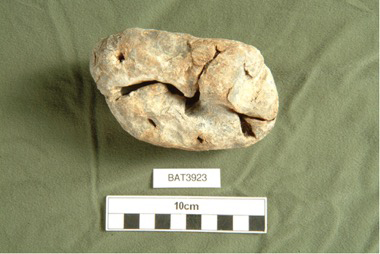Stop 4.4 - Batavia Archaeology: Morning Star
Now a crumpled piece of lead, the original function of this object is not immediately obvious. But it is believed to be the head of a deadly weapon known a ‘morning star' or – in Dutch – a morgenster.
This object would have been attached to a rope or to a haft or handle made of wood. The small holes covering its surface would have held spikes, likely made from sharp nails, which gave the weapon a star-like appearance. It could be used with brute force to bludgeon an opponent, its vicious spikes creating additional puncture wounds.
The artefact was found during an archaeological investigation of Long Island, a coral island in the Houtman Abrolhos, an island group off the coast of Western Australia. After the Dutch East India Company ship known as the Batavia was wrecked in 1629, this island became the site of a brutal massacre. When the captain, Francisco Pelsaert, took most of the ship's senior officers on an expedition to find water, Jeronimus Cornelisz, the ship's under merchant, led a violent mutiny during which a large number of the survivors – many of them women and children – were murdered.
The confessions of several mutineers reveal that a morning star was one of the weapons used in the murder of Frans Janz, the Batavia's surgeon. On the 5th of August, Janz's murderers had led him away from the campsite, on the pretence of going seal hunting. Instead, the mutineers turned on him, killing him in a brutal frenzy, out of sight of the rest of the community. His attackers ran him through with a pike and struck him on the head with a morning star. His head was then split with a sword and his body was stabbed. Just one of these injuries could have killed Janz.
The extreme and unnecessary brutality of the Batavia murders suggests the mutineers' enjoyment of killing. The murderers were armed and their victims were not. Their weapons were therefore instruments of intimidation, fear, and coercion. The wielder of this object might have felt powerful carrying it – its very presence a symbol of his authority and of the hidden violence he had perpetrated. For the mutineers' victims, however, it would likely have provoked feelings of terror.


